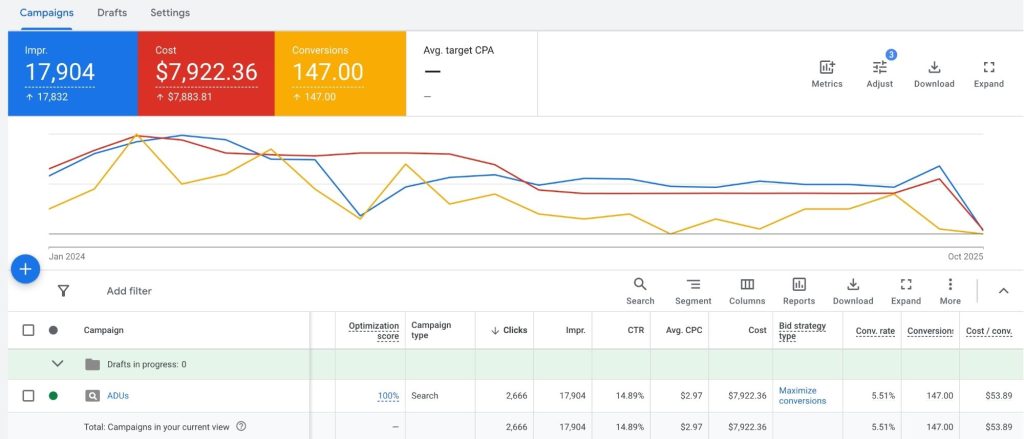Why the Funnel Matters in Construction
When people hear “marketing funnel,” they often think of e-commerce — quick clicks, impulse buys, and cart checkouts. Construction doesn’t work that way. With high-value projects and long sales cycles, your funnel is about capturing intent, building trust, and nurturing prospects until they’re ready to move forward.
The key to making profitable marketing investments in construction is to start with the lowest hanging fruit — capturing demand that already exists — before you invest in brand awareness or top-of-funnel tactics.
Step 1: Capture Existing Demand First
If you’re just starting out, the worst mistake you can make is spreading your budget across too many channels. Referrals and word-of-mouth are powerful, but if you want to generate leads digitally, the fastest way is through bottom-of-funnel (BOFU) strategies like:
- PPC Search Ads (Google Ads): Capture people actively searching for “kitchen remodeler in Denver” or “custom home builder near me.”
- SEO Service Pages: Rank organically for service + location keywords.
- Strong CTAs on Your Website: Make it as easy as possible for someone to call, book a consultation, or request a quote.

At this stage, ignore organic social or “fun” top-of-funnel content. Those tactics pay off later, but right now you need leads. And while a strong personal brand on social media can be fruitful, understand that the effort and cost associated with doing this to an appropriate degree is hefty.
Step 2: Know When to Layer in TOFU
You’ll know you’ve maxed out BOFU when:
- Your paid ad spend keeps going up, but cost per lead is rising instead of falling.
- You’re spending your entire budget but not seeing more conversions, because you’ve saturated search volume in your area.
- You’re capturing all the demand, but growth has slowed.
- Your search impression share in Google PPC is extremely high.
That’s the signal to reinvest some of your budget into top- and middle-of-funnel strategies like video ads, blog content, or PR. Those tactics build demand and keep you growing past the initial ceiling.
A 90-Day Quick-Win Plan for Remodelers
Here’s what we recommend to remodeling companies starting from zero:
Month 1
- Build your Ideal Customer Profile (ICP) to clarify services and audiences.
- Do keyword research to lock in your strategy.
- Launch a clean, conversion-focused website with analytics tracking.
Month 2
- Launch PPC search campaigns to start capturing leads immediately.
- Create your SEO strategy outline (priority pages + blog clusters).
Month 3
- Optimize ads based on first results.
- Begin producing and publishing SEO content.
Months 4-6
- Keep refining PPC.
- Stay consistent with SEO content.
Months 6-12
- If PPC and SEO are working well, layer in a CRM, email nurture sequences, or selective social campaigns — depending on how many leads you’re getting and what your team can handle.
This timeline is all dependent upon your time commitment each month. If you invest more time and money into marketing you can speed this timeline up, or keep the timeline but see bigger gains from each channel.
Budget Splits That Work
We recommend budget splits based on where you are in your maturity:
- $1,000 – $3,000/month: Go all-in on PPC search campaigns. Don’t spread thin.
- $4,000+/month: Start splitting budget 70% PPC, 30% Meta Ads (Facebook/Instagram). Meta can drive volume, but search captures the highest intent.

Reporting Timelines That Make Sense
Marketing takes time, but here’s what you should expect if things are set up correctly:
- Month 1: Launch website. No real data yet.
- Month 2: Launch campaigns. Early data coming in.
- Month 3: First PPC results and initial conversions.
- Months 4-6: Refined PPC cost per lead, higher-quality results, early organic rankings.
- Months 6-9: First page SEO rankings showing up, even if not top 3.
- Months 9-12: Competitive rankings in positions 1–3*, consistent organic leads flowing in.
A key consideration for both cost-per-lead in paid advertising and organic rankings is market saturation and competition. Emerging products with high demand (for example, ADUs) may see quicker results and lower costs, while a common service like bathroom remodels in a market like California will likely see slower results and higher costs.
Bottom Line
If you’re a construction company with a limited budget, your best bet is to capture demand first. Build a simple but powerful funnel: website → PPC → SEO. Once you’ve maxed out existing demand, layer in top-of-funnel and retention strategies to create demand and scale past plateaus.
Ready to Build Your Construction Marketing Funnel?
At Nover Marketing, we build funnels tailored for the construction industry — from remodelers starting with a $1,000 ad budget to commercial builders ready to scale with full-funnel campaigns. Because we only work with architecture, engineering, and construction clients, we know how to balance quick wins with long-term growth. For example, we launched an ADU builder from scratch with zero online presence and within one year helped them surpass $1M in closed contracts, fully booking out their builds for the following twelve months.
If you’re ready to stop guessing and start growing, book a free consultation with our team today. We’ll design a construction marketing funnel that drives contractor lead generation, captures demand quickly, and positions your business for sustainable growth.